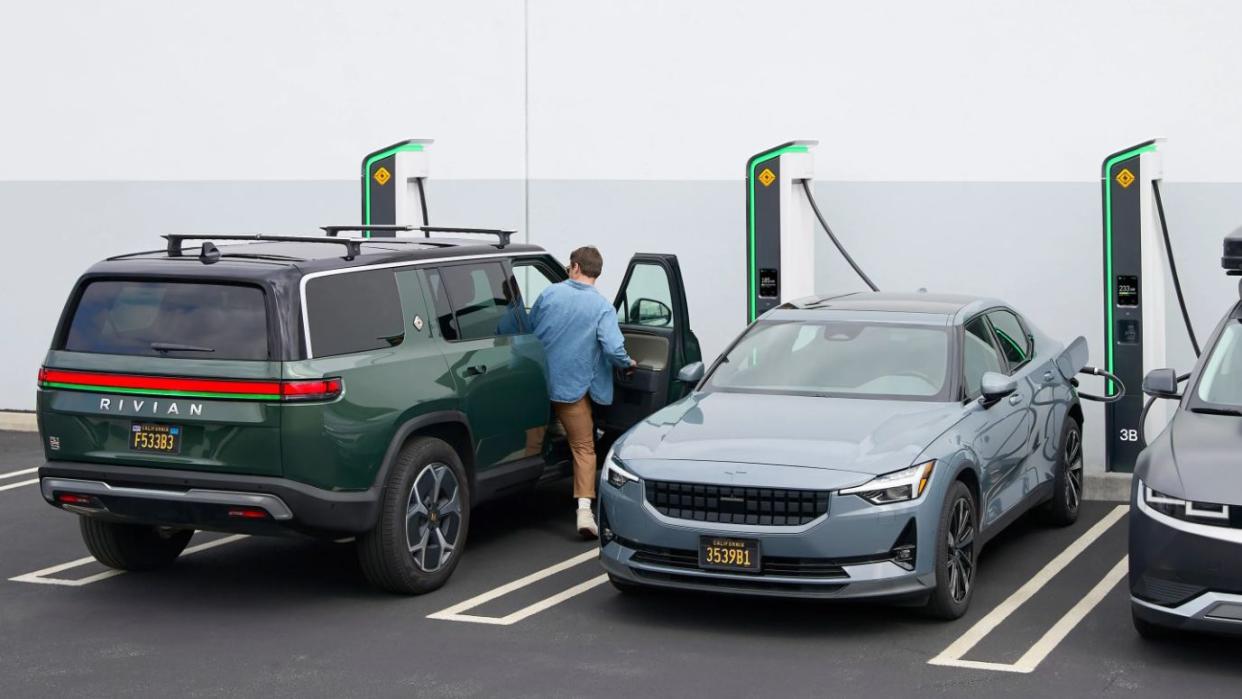Rivian Will Open Its Charging Network to Other EVs—and Will Offer 800V Capability

The Rivian Adventure Network of DC fast-chargers, once intended exclusively for the use of Rivian owners, will be open to other EVs with CCS ports starting later this year.
Rivian unveiled a new charger design, aimed at 400- and 800-volt architectures and offering new features, that will be installed at newly built stations.
The EV maker plans to make the switch to Tesla's North American Charging Standard (NACS) ports starting in 2025, for now offering adapters for NACS chargers.
The past year saw over a dozen automakers strike deals with Tesla for owners of their EVs to use the Supercharger network, built up over a decade and a half and now counting over 2300 stations in the US alone.
Now Rivian is doing the same.
The startup revealed that it will open up its Rivian Adventure Network (RAN) to other EVs later this year, while also adding a tap-to-pay option.
For now, Rivian's chargers support the CCS connector standard, even though Rivian has made plans to migrate to Tesla's North American Charging Standard (NACS) in its vehicles starting in 2025.
So a transitional period is likely on the horizon that will see Rivian stations offer both CCS and NACS cables, with Rivian having just started distributing NACS adapters to its owners free of charge.
Like Tesla, Rivian has been building its own charging network just for owners of its vehicles, albeit on a smaller scale, having started later. Rivian actually invested in not one but two networks, with its exclusive RAN offering DC fast-chargers, while Rivian Waypoints has been designed from the start for all EVs, offering slower Level 2 speeds.
At the moment, Rivian has about 400 individual chargers at some 67 stations but eventually plans to expand it to a total of about 3,500 chargers across 600 stations in the US and Canada.
"By broadening access to our Rivian Adventure Network—powered by 100% renewable energy—we are supporting both of these critical goals while also encouraging more people to embark on their next adventure in an EV," said Paul Frey, Rivian Vice President of Battery, Charging, and Adventure Products.
In addition to opening up the RAN to other EVs, Rivian took the wraps off a new CCS charger design developed in-house for vehicles with 400- and 800-volt architectures. (Current Rivians can charge at rates up to 400 volts.)
This new charger, which will feature longer cables to accommodate a variety of charging port placements, will support NACS adapters before making the hardware switch to NACS later on.
All newly built RAN locations will feature this new charger, with the first units slated to be installed later this year.
"This next-generation charging hardware, engineered and built by Rivian in Normal, Illinois, seeks to provide that same reliable experience to the larger EV community," Rivian notes, adding that the RAN network has shown an uptime of over 98%.
With charging woes still seen as one of the main barriers to greater EV adoption, greater consolidation of networks and charging standards was perhaps inevitable after the first few years of VHS/Beta-style format wars.
Will the availability of Tesla's Supercharger Network increase EV adoption in the coming years, or is price still a bigger factor? Let us know what you think in the comments below.

